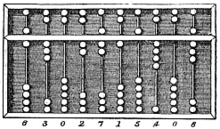
The earliest known written documentation of the Chinese abacus dates to the 2nd century BC.[15]
The Chinese abacus, known as the suànpán (算盤, lit. "Counting tray"), is typically 20 cm (8 in) tall and comes in various widths depending on the operator. It usually has more than seven rods. There are two beads on each rod in the upper deck and five beads each in the bottom for both decimal and hexadecimal computation. The beads are usually rounded and made of a hardwood. The beads are counted by moving them up or down towards the beam. If you move them toward the beam, you count their value. If you move away, you don't count their value.[16] The suanpan can be reset to the starting position instantly by a quick jerk along the horizontal axis to spin all the beads away from the horizontal beam at the center.
Suanpans can be used for functions other than counting. Unlike the simple counting board used in elementary schools, very efficient suanpan techniques have been developed to do multiplication, division, addition, subtraction, square root and cube root operations at high speed. There are currently schools teaching students how to use it.
In the famous long scroll Along the River During the Qingming Festival painted by Zhang Zeduan (1085–1145 AD) during the Song Dynasty (960–1297 AD), a suanpan is clearly seen lying beside an account book and doctor's prescriptions on the counter of an apothecary's (Feibao).
The similarity of the Roman abacus to the Chinese one suggests that one could have inspired the other, as there is some evidence of a trade relationship between the Roman Empire and China. However, no direct connection can be demonstrated, and the similarity of the abaci may be coincidental, both ultimately arising from counting with five fingers per hand. Where the Roman model (like most modern Japanese) has 4 plus 1 bead per decimal place, the standard suanpan has 5 plus 2, allowing use with a hexadecimal numeral system. Instead of running on wires as in the Chinese and Japanese models, the beads of Roman model run in grooves, presumably making arithmetic calculations much slower.
Another possible source of the suanpan is Chinese counting rods, which operated with a decimal system but lacked the concept of zero as a place holder. The zero was probably introduced to the Chinese in the Tang Dynasty (618-907 AD) when travel in the Indian Ocean and the Middle East would have provided direct contact with India, allowing them to acquire the concept of zero and the decimal point from Indian merchants and mathematicians.

























No comments:
Post a Comment